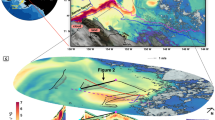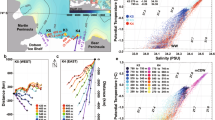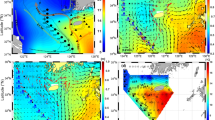Abstract
The primary paths for the transport of Antarctic Bottom Water from the Southern Ocean into the global ocean are the deep western boundary currents east of the Antarctic Peninsula and the Kerguelen plateau1. Previous ship-based observations documented distinct water properties and velocities associated with a deep western boundary current in the Kerguelen region2,3,4,5,6,7, but the mean flow is as yet unconstrained. Here we report measurements from a coherent array of eight current-meter moorings that reveal a narrow and intense equatorward flow extending throughout the water column just east of the Kerguelen plateau. Velocities averaged over two years exceed 20 cm s−1 at depths of about 3,500 m, the strongest mean deep western boundary current flow yet observed at similar depths. We estimate the mean equatorward transport of water colder than 0 ∘C at 12.3±1.2×106 m3 s−1, partially compensated by poleward flow. We also estimate the net equatorward flow of water colder than 0.2 ∘C at about 8×106 m3 s−1, substantially higher than the 1.9×106 m3 s−1 reported from the boundary current that carries dense water from the Weddell Sea into the Atlantic Ocean north of the Falkland plateau8. We conclude that the Kerguelen deep western boundary current is a significant pathway of the global ocean’s deep overturning circulation.
This is a preview of subscription content, access via your institution
Access options
Subscribe to this journal
Receive 12 print issues and online access
$259.00 per year
only $21.58 per issue
Buy this article
- Purchase on Springer Link
- Instant access to full article PDF
Prices may be subject to local taxes which are calculated during checkout



Similar content being viewed by others
References
Orsi, A. H., Johnson, G. C. & Bullister, J. L. Circulation, mixing, and production of Antarctic Bottom Water. Prog. Oceanogr. 43, 55–109 (1999).
Speer, K. G. & Forbes, A. A deep western boundary current in the South Indian basin. Deep-Sea Res. I 41, 1289–1303 (1994).
Donohue, K., Hufford, G. E. & McCartney, M. S. Sources and transport of the deep western boundary current east of the Kerguelen plateau. Geophys. Res. Lett. 26, 851–854 (1999).
Narumi, Y., Kawamura, Y., Kusaka, T., Kitade, Y. & Nagashima, H. The Deep Western Boundary Current along the eastern slope of the Kerguelen plateau in the Southern Ocean: Observed by the Lowered Acoustic Doppler Profiler (LADCP). La Mer 43, 49–59 (2005).
McCartney, M. S. & Donohue, K. A. A deep cyclonic gyre in the Australian–Antarctic basin. Prog. Oceanogr. 75, 675–750 (2007).
Aoki, S. et al. Deep western boundary current and southern frontal systems of the Antarctic Circumpolar Current southeast of the Kerguelen Plateau. J. Geophys. Res. 113, C08038 (2008).
Park, Y-H., Vivier, F., Roquet, F. & Kestenare, E. Direct observations of the ACC transport across the Kerguelen plateau. Geophys. Res. Lett. 36, L18603 (2009).
Whitworth, T. III, Nowlin, W. D., Pillsbury, R. D., Moore, M. I. & Weiss, R. F. Observations of the Antarctic Circumpolar Current and deep boundary current in the Southwest Atlantic. J. Geophys. Res. 96, 15105–15118 (1991).
Stommel, H. & Arons, A. B. On the abyssal circulation of the World Ocean-I. Stationary planetary flow patterns on a sphere. Deep-Sea Res. 6, 140–154 (1960).
Rintoul, S. R. in Ocean, Ice, and Atmosphere: Interactions at the Antarctic Continental Margin (eds Jacobs, S. S. & Weiss, R. R.) 151–171 (Antarct. Res. Ser., Vol. 75, American Geophysical Union, 1998).
Fahrbach, E., Harms, S., Rohardt, G., Schröder, M. & Woodgate, R. A. Flow of bottom water in the northwestern Weddell Sea. J. Geophys. Res. 106, 2761–2778 (2001).
Nakano, H. & Suginohara, N. Importance of the eastern Indian Ocean for the abyssal Pacific. J. Geophys. Res. 107, 3219 (2002).
Orsi, A. J., Smethie, W. M. Jr & Bullister, J. L. On the total input of Antarctic waters to the deep ocean: A preliminary estimate from chlorofluorocarbon measurements. J. Geophys. Res. 107, 3122 (2002).
Fahrbach, E., Rohardt, G., Schröder, M. & Strass, V. Transport and structure of the Weddell Gyre. Ann. Geophys. 12, 840–855 (1994).
Carmack, E. C. in Voyage of Discovery (ed. Angel, M.) Deep-Sea Res. 24 (suppl.), 15–37 (1977).
Moore, M. I. & Wilkin, J. L. Variability in the South Pacific Deep Current from current meter observations and a high-resolution global model. J. Geophys. Res. 103, 5439–5457 (1998).
Schott, F. A. et al. Circulation and deep-water export at the western exit of the subpolar north Atlantic. J. Phys. Oceanogr. 34, 817–842 (2004).
Bryden, H. L., Johns, W. E. & Saunders, P. M. Deep western boundary current east of Abaco: Mean structure and transport. J. Mar. Res. 63, 35–57 (2005).
Schott, F. A., Fisher, J., Dengler, M. & Zantopp, R. Variability of the Deep Western Boundary Current east of the grand banks. Geophys. Res. Lett. 33, L21S07 (2006).
McCartney, M. S. Recirculating components of the deep boundary current of the northern North Atlantic. Prog. Oceanogr. 29, 283–383 (1992).
Naveira Garabato, A. C., McDonagh, E. L., Stevens, D. P., Heywood, K. J. & Sanders, R. J. On the export of Antarctic Bottom Water from the Weddell Sea. Deep-Sea Res. II 49, 4715–4742 (2002).
Cunningham, S. A. et al. Temporal variability of the Atlantic meridional overturning circulation at 26.5∘ N. Science 317, 935–938 (2007).
Kanzow, T. et al. Observed flow compensation associated with the MOC at 26.5∘ N in the Atlantic. Science 317, 938–941 (2007).
Johns, W. E. et al. Variability of shallow and deep western boundary currents off the Bahamas during 2004–05: Results from 26∘ N RAPID-MOC array. J. Phys. Oceanogr. 38, 605–623 (2008).
Weaver, A. J., Saenko, O. A., Clark, P. U. & Mitrovica, J. X. Meltwater pulse 1 A from Antarctica as a trigger of the Bølling–Allerød warm interval. Science 299, 1709–1713 (2003).
Meehl, G. A. et al. in IPCC Climate Change 2007: The Physical Science Basis. Contribution of Working Group I to the Fourth Assessment Report of the Intergovernmental Panel on Climate Change (eds Solomon, S. et al.) (Cambridge Univ. Press, 2007).
Sen Gupta, A. et al. Projected changes to the Southern Hemisphere ocean and sea ice in the IPCC AR4 climate models. J. Clim. 22, 3047–3078 (2009).
Sokolov, S. & Rintoul, S. R. Circumpolar structure and distribution of the Antarctic Circumpolar Current fronts: 1. Mean circumpolar paths. J. Geophys. Res. 114, C11018 (2009).
Le Traon, P., Nadal, F. & Ducet, N. An improved mapping method of multisatellite altimeter data. J. Atmos. Ocean. Technol. 15, 522–534 (1998).
Gouretski, V. V. & Koltermann, K. P. WOCE Global Hydrographic Climatology. A Technical Report, 35 (Berichte des BSH, 2004).
Acknowledgements
We are deeply indebted to D. McLaughlan and K. Miller for their mooring works. Thanks are extended to the officers, crew and scientists on board RSV Aurora Australis for their help with field observations. Discussions with G. Mizuta and Y. Kashino were helpful. Figure 1a was drawn by L. Bell and K. Kitagawa. Other figures were produced by the PSPLOT library written by K. E. Kohler. In Japan, support was provided by Grants-in-Aid 14403006, 17340138, 20244075, 20540419 and 21310002 for Scientific Research from Ministry of Education, Science, Sports and Culture. In Australia, support was provided by the Cooperative Research Centre program of the Australian government and by the Australian National Antarctic Research Expeditions; this work is a contribution to the Australian Climate Change Science Program, funded jointly by the Department of Climate Change, the Bureau of Meteorology and CSIRO.
Author information
Authors and Affiliations
Contributions
J.A.C., M.W., S.R.R. and Y.F. planned the experiment; M.A.R., Y.F., S.R.R., J.A.C., S.A. and S.S. carried out the observations; Y.F., M.A.R., S.S. and S.A. carried out data processing; Y.F., S.R.R., J.A.C., S.S. and M.W. wrote the manuscript, with other authors commenting.
Corresponding author
Ethics declarations
Competing interests
The authors declare no competing financial interests.
Supplementary information
Supplementary Information
Supplementary Information (PDF 239 kb)
Rights and permissions
About this article
Cite this article
Fukamachi, Y., Rintoul, S., Church, J. et al. Strong export of Antarctic Bottom Water east of the Kerguelen plateau. Nature Geosci 3, 327–331 (2010). https://doi.org/10.1038/ngeo842
Received:
Accepted:
Published:
Issue Date:
DOI: https://doi.org/10.1038/ngeo842
This article is cited by
Diversity and distribution of viruses inhabiting the deepest ocean on Earth
The ISME Journal (2021)
Reversal of freshening trend of Antarctic Bottom Water in the Australian-Antarctic Basin during 2010s
Scientific Reports (2020)
An oceanic 'fast-lane' for climate change
Nature (2010)
Recycling bottom waters
Nature Geoscience (2010)



